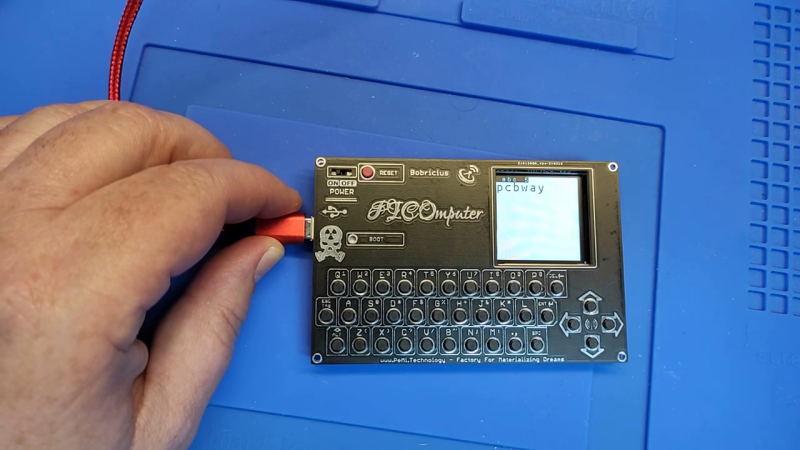Independent hardware developer [bobricius] is at it again, making what he claims is the world’s first Pico RP2040 QWERTY + IPS development kit — the PICOmputer. This is a palm-sized computer of sorts. It integrates a keyboard made from tactile push button switches, a TFT IPS display, and a RP2040 Pico computer module. At 100 x 65 mm size, it is slightly bigger than your typical ISO-7810-ID-1-sized credit card, and slightly smaller than an A7 piece of paper.
One of [Bobricius]’s goals for this project was to minimize the number of external components, thus maximizing the use of the RP2040’s internal features. And if you peruse the schematic posted on his GitHub repository, you can agree he’s met this goal for sure. There’s a filter capacitor for the optional LoRa module, and two MOSFETs and three resistors to drive a speaker and the TFT backlight. Aside from connectors, the switches, and the submodules themselves, that’s all of the external circuitry.
The arrangement of two USB connectors, type C for power and micro-USB for data, is an interesting aspect of the connector / module placement. He plans to add an Ethernet module in the future, and issue some more revisions to fix small errors and to make the front panel fit more sizes of displays. We wonder if a battery module add-on is in the works, as well.
If you recognize [bobricius], that’s because his previous ARMACHAT handheld LoRa messenger project was among the Hackaday Prize Community Vote (Bootstrap) winners last year. We think tiny keyboards may be an obsession for him — indeed, he freely admits to being blinded by his own enthusiasm. Check out his mini (Pi)QWERTY USB keyboard from 2018, for example. Thanks to [Itay] for bringing this project to our attention via the Hackaday tip line.

















This would make a great LoRA messaging terminal – really neat!
He has already made several standalone Lora messaging computers. I think there’s a link in the article.
You were so fast being the first commeting here that you had no time reading the article ?
Too uncomfortable for me, I’ll accept even a phone, but not this small keyboard… my hands are thin, but those buttons are the hell
Nice,
I hope he can get a larger display, one close to the width of the keyboard, for it.
And a battery backpack.
And..[feature creep]
I’m praying for a low power LoRa VT100-ish tool … but Santa seems deaf… :-(
I plan on adding an ESP32 LoRA board to https://hackaday.io/project/163829-vt-69-handheld-terminal when it comes out.
So… Is it just me, or does this scream to be “rebuilt” as Tandy Model 100 Laptop in small form factor?
Very small form factor, yes.
But remember, one of the key selling points of the Model 100 was its full-size keyboard and its ability to run off dry cell batteries.
I would like to know more about it.
I love these projects and view them all with envy.
There is a derth of simple serial(ps2) qwerty keyboards for small devices, maybe cannibalized x-box chat keyboards if you can find a used one. It would be cool if there were a cheap source of various mini sized keyboards like this for those of us without a PCB and pick&place rig who seek a Zaurus, N900, or blackberry type hardware keyboard to fill our parts cabinets for our one-off projects.
You really don’t need pick and place to make a keyboard. You don’t even need a PCB. Think outside the box. Any piece of flat, stiff plastic, along with some contact cement and some 30-gauge wire can make a keyboard. Don’t be envious, just get in the game.
I wonder if he’s going to add the ability to type a backslash. I see a forward slash as an alt on one of the keys, but no backslash.
Actually I wish these were available soldered and ready like the pinephone is(already checked tindie).
Plenty of us tinkerers and hackers have become disabled and SMD especially is just no longer an option without a nimble apprentice so we are frozen out.
No pressure on this or any individual dev but when you cant work(so no $$$) and cant solder either these cool projects slip out of the hands of those potential users who have so much unused time to kill.
Plenty of us aren’t disabled but would still fail to solder SMD stuff…
I know it doesn’t help with this project in particular, but I’d recommend checking out JLCPCB’s SMD assembly service. You do have to use their parts library, so you have to design to what’s available, but when you can make it work it’s really nice and unbelievably cheap compared to normal board assembly. If you can solder through-hole parts, then whatever parts aren’t in their library you can solder yourself – especially useful for prebuilt modules e.g. from Sparkfun or Adafruit.
I hate doing rats-nest soldering, but I love the design challenge of PCBs, so I tend to do this a lot.
and big and heavy power bank for this ;(
why not integrate power/ solar panel/ nuclear plant !
It would be great if someday an basic interpreter for this computer will appear.
I’m not considering BASIC, but I am looking at using two R-Pi Picos in one handheld, one as a terminal, the other as a Python editor/interpreter. Might even work to do both on the same Pico, but with the amount of RAM needed to keep a decent-size screen refreshed, that would be cutting into the memory available for programs.
And here’s a similar earlier project from him based around the Pi Zero:
https://hackaday.io/project/176706-zepir-raspberry-pi-zero-mini-computer
Does it support Hebrew?